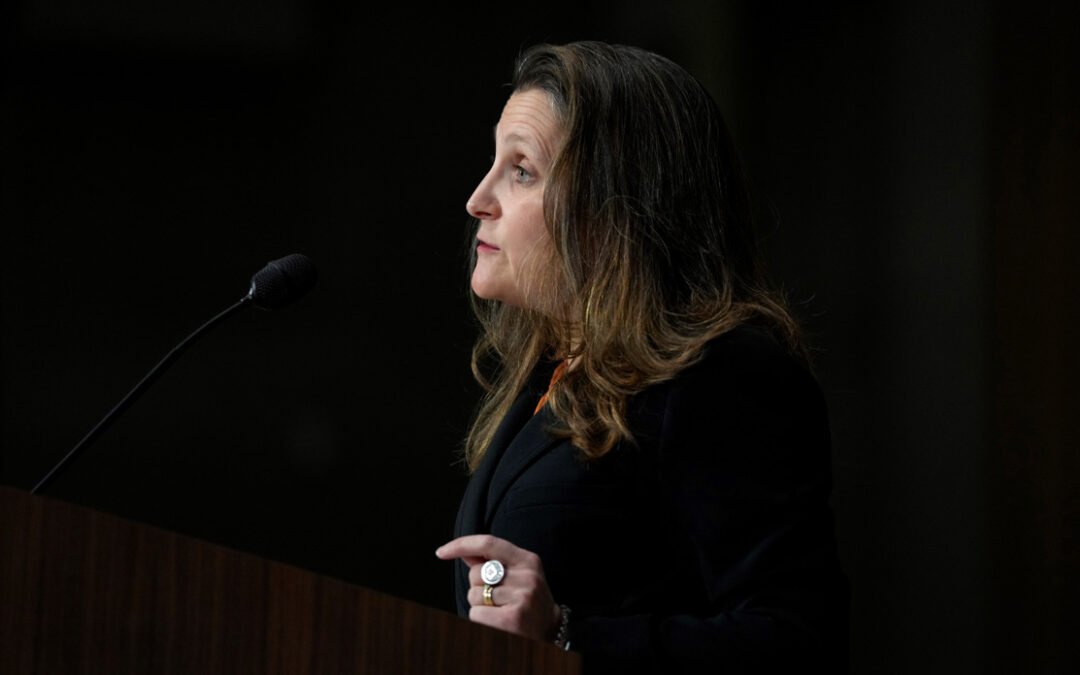While investing in new priorities including housing, defence, and dental care
Since the announcement of the Liberal-NDP confidence and supply agreement a mere two weeks ago, business and political commentators have fretted over the sustainability of Canada’s fiscal framework out of fear of permanent new spending commitments.
The 2022 federal budget, presented today by Deputy Prime Minister and Minister of Finance Chrystia Freeland, should help to allay some of those concerns, buoyed by strong economic growth and a $85.5 billion windfall in tax revenue over the next five years boosted in part by higher commodity prices.
Despite high inflation, Canada has recovered 112 per cent of jobs lost since before the pandemic, and now boasts a 5.5 per cent unemployment rate – close to Canada’s record from 2019. Following a strong rebound of 4.6 per cent in 2021, real GDP is expected to grow by a solid 3.9 per cent in 2022 and by 3.1 per cent in 2023.
FISCAL FRAMEWORK
Thanks in part to these strong economic fundamentals, Canada has emerged from the pandemic with a surprisingly resilient balance sheet. Despite hundreds of billions in new spending on pandemic programs over the last two years, the federal treasury remains in an enviable position. Thanks to low interest rates, higher than expected commodity prices, and strong demand for Canadian treasury bonds, the cost of servicing Canada’s debt relative to the size of our economy is at a historic low.
Budget 2022 projects that Canada will approach a balanced budget in 5 years, decreasing from a $113 billion deficit last year, to $52 billion this year, $40 billion next year, down to $8 billion in 2026-27.
The budget clocks in at $34.9 billion in new spending over 5 years – far less than the $101 billion over 3 in last year’s mega budget, and even less than the $78 billion over 5 years promised in the Liberals’ election platform. The budget also includes a modest program review, with a view to reducing the pace and scale of spending that has yet to occur by up to $3 billion over the next four years.
NEW TAXES
The government has moved forward with new taxes on banks and life insurance companies. The temporary Canada Recovery Dividend will require banking and life insurance companies to pay a one-time 15 per cent tax on taxable income above $1 billion for the 2021 tax year, to be paid in equal installments over five years. Budget 2022 also proposes to permanently increase the corporate income tax rate by 1.5 per cent for these companies with revenues above $100 million. Together, these measures are expected to raise $6.1 billion over five years, with the 1.5 per cent permanent tax on banking and life insurance companies expected to raise $445 million ongoing.
Budget 2022 will also close loopholes that currently allow for the use of foreign corporations to avoid Canadian tax – a measure that would increase federal revenues by $4.2 billion over five years starting in 2022-23.
HOUSING
The government is branding this as a “housing budget,” following through on a key theme in the 2021 Liberal platform in response to the housing affordability crisis across the country. Their headline commitment is a plan to double the number of new homes being built in Canada. The government’s $10 billion investment in affordable housing includes:
- A new housing accelerator fund, designed to be flexible and support an annual per-door incentive for municipalities, or upfront funding for investments in municipal housing planning and delivery process that will speed up housing developments.
- Reforms to the Rental Construction Financing Initiative, strengthening its affordability and energy efficiency requirements. Developers who significantly exceed these requirements and build highly affordable and energy efficient units will be eligible to have a portion of their repayable loans converted to nonrepayable loans.
- A one-time $500 payment to those facing housing affordability challenges.
In addition to the above supply-focused policy solutions, Budget 2022 adds new tools to help the demand side of the housing market. These include a new Tax-Free First Home Savings Account, which allows home buyers the ability to save up to $40,000. Like an RRSP, contributions are tax-deductible, and withdrawals to purchase a first home – including investment income – would be non-taxable like a TFSA. Tax-free in, tax-free out.
The government is also proposing to introduce legislation to ban certain foreign entities and individuals who are not Canadian citizens or permanent residents from acquiring non-recreational, residential property in Canada for a period of two years.
ECONOMIC DEVELOPMENT
The budget earmarks $15 billion over five years for a Growth Fund to attract private investment in new and green technologies. The money being set aside for the fund will come from the existing fiscal framework and the government will seek to attract $3 of private investment for every $1 of public funding. The government hopes to achieve three economic policy goals:
- To reduce emissions and contribute to achieving Canada’s climate goals;
- To diversify the economy and bolster exports by investing in the growth of low-carbon industries and new technologies across new and traditional sectors of Canada’s industrial base; and
- To support the restructuring of critical supply chains in areas important to Canada’s future prosperity—including our natural resources sector.
The government is also creating a “Canadian Innovation and Investment Agency” and proposes $1 billion over five years, starting in 2022-23, to support its initial operations. This agency will proactively work with new and established Canadian industries and businesses – including in the Canadian defence sector – to help them make R&D investments to innovate, grow, create jobs, and be competitive in the changing global economy.
DEFENCE
Minister Freeland’s budget speech included a firm message of opposition to Russia’s illegal invasion of Ukraine. Not typically a focus of Liberal spending plans, the government announced $8 billion in new defence spending, partially in response to the call from Ukrainian President Volodymyr Zelenskyy for more military support.
The lion’s share of this new spending is $6.1 billion over five years in order to meet defence priorities, including continental defence, commitments to our allies, and investments in equipment and technology to immediately increase the capabilities of the Canadian Armed Forces.
Budget 2022 earmarks more than $1.2 billion in direct contributions in support of Ukraine, along with loan support for up to $1.6 billion.
CLIMATE
The budget included $9.1 billion in new climate measures that were announced in last week’s Emissions Reduction Plan. The marquee new climate announcement today was the expected Investment Tax Credit for Carbon Capture, Utilization, and Storage, a suite of technologies that capture carbon dioxide (CO2) emissions—whether from fuel combustion, industrial processes, or directly from the air—to either store the CO2 typically deep underground, or to use it in other industrial processes such as permanent mineralization in concrete.
Budget 2022 proposes a refundable investment tax credit for businesses that incur eligible CCUS expenses, starting in 2022. Eligible CO2 uses include dedicated geological storage and storage of CO2 in concrete, but does not include enhanced oil recovery. From 2022 through 2030, the investment tax credit rates would be set at:
- 60 per cent for investment in equipment to capture CO2 in direct air capture projects;
- 50 per cent for investment in equipment to capture CO2 in all other CCUS projects; and
- 37.5 per cent for investment in equipment for transportation, storage and use.
To encourage the industry to move quickly to lower emissions, these rates will be reduced by 50 per cent for the period from 2031 through 2040. The proposed refundable tax credit is expected to cost $2.6 billion over five years starting in 2022-23, with an annual cost of about $1.5 billion in 2026-27. Going forward, it is expected that the measure will continue to cost approximately $1.5 billion annually until 2030.
RECONCILIATION
Reconciliation continues to be a major priority for the government. In addition to the $20 billion legal settlement announced earlier this year to end discrimination in the First Nations Child and Family Services program, the government announced new funding for Indigenous housing, health, residential school investigations, and economic development. Major investments include:
- $4 billion over seven years, starting in 2022-23, to Indigenous Services Canada and Crown-Indigenous Relations and Northern Affairs Canada to accelerate work in closing the Indigenous housing gap.
- $150 million over five years, starting in 2022-23, to Indigenous Services Canada’s Lands and Economic Development Services Program and Community Opportunity Readiness Program, to advance shovel-ready economic opportunities in Indigenous communities.
- $398 million over two years, starting in 2022-23, to Indigenous Services Canada to support community infrastructure on reserve, of which at least $247 million will be directed toward water and wastewater infrastructure.
- $227.6 million over two years, starting in 2022-23, to maintain trauma-informed, culturally-appropriate, Indigenous-led services to improve mental wellness, and to support efforts initiated through Budget 2021 to co-develop distinctions-based mental health and wellness strategies.
- $103.4 million over five years, starting in 2022-23, to Natural Resources Canada to develop a National Benefit-Sharing Framework, and the expansion of both the Indigenous Partnership Office and the Indigenous Natural Resource Partnerships program. At least $25 million of this funding should be dedicated to early engagement and Indigenous communities’ capacity building to support their participation in the critical minerals strategy.
- $29.6 million over three years, starting in 2022-23, to Crown-Indigenous Relations and Northern Affairs Canada to support the co-development of an Indigenous Climate Leadership Agenda to support self-determined action in addressing Indigenous peoples’ climate priorities.
- $65.8 million over five years, starting in 2022-23, and $11 million ongoing, to Justice Canada and Natural Resources Canada to accelerate work to meet legislated requirements, including the co-development of an action plan with Indigenous partners.
HEALTH AND DENTAL CARE
The big win for the NDP in the budget is a new dental care program worth $5.3 billion over five years, starting in 2022-23, and $1.7 billion ongoing. Starting with Canadians under 12-years-old in 2022, the program will expand to under 18-year-olds, seniors, and persons living with a disability in 2023, with full implementation by 2025. The program would be restricted to families with an income of less than $90,000 annually, with no co-pays for those under $70,000 annually in income.
Several other health measures caught our attention:
- The federal government committed to tabling a Canada Pharmacare bill and working to have it passed by the end of 2023, before tasking the Canadian Drug Agency to develop a national formulary of essential medicines and a bulk purchasing plan.
- $100 million over three years, starting in 2022-23, to Health Canada for the Substance Use and Addictions Program to support harm reduction, treatment, and prevention at the community level.
- $20 million over five years, starting in 2022-23, for the Canadian Institutes of Health Research to ramp up efforts to learn more about dementia and brain health, to improve treatment and outcomes for persons living with dementia, and to evaluate and address mental health consequences for caregivers and different models of care.
- Budget 2022 proposes to allow medical expenses related to a surrogate mother or a sperm, ova, or embryo donor that are incurred in Canada for 2022 and subsequent taxation years to be claimed. This would include costs that have been reimbursed to a surrogate for in vitro fertilization expenses.
- Budget 2022 also proposes to allow fees paid to fertility clinics and donor banks in Canada in order to obtain donor sperm and ova to be eligible under the Medical Expense Tax Credit for 2022 and subsequent taxation years.
SKILLS TRAINING
Budget 2022 aims to address labour shortages and remove barriers to employment by investing in skills training for Canadian workers. Budget 2022 proposes:
- $84.2 million over four years to double funding for the Union Training and Innovation Program to help 3,500 apprentices from underrepresented groups begin and succeed in careers in the skilled trades through mentorship, career services, and job-matching.
- $35 million over five years, starting in 2022-23, to Indigenous Services Canada to increase economic capacity supports, including specialized training opportunities delivered by Indigenous-led organizations.
- $2.5 million in 2022-23 for Employment and Social Development Canada to launch a new union-led advisory table to advise the government on priority investments to help workers navigate the changing labour market, with a particular focus on skilled, mid-career workers in at-risk sectors and jobs.
The government is also working with the provinces and territories to become more responsive to the needs of workers, employers and the economy by:
- Proposing to amend Part II of the Employment Insurance Act to ensure more workers are eligible for help before they become unemployed, and that employers can receive direct support to re-train their workers; and
- Renewing the Labour Market Transfer Agreements, more than $3 billion per year in funding to provide training and employment support through programs ranging from skills training and wage subsidies, to career counselling and job search assistance.
WOMEN AND GENDER EQUALITY
The government continues to apply a feminist lens to its spending, as budget 2022 includes some key funding envelopes for women-focused programs. This includes over half a billion over five years in support of provinces and territories to supplement and enhance services and supports within their jurisdictions to prevent gender-based violence and support survivors.
Building off the investments in housing, 25 per cent of the funding reserved for new affordable housing is reserved for women-focused housing projects.
In addition, Women and Gender Equality will be provided $25 million over two years to establish a national pilot project for a Menstrual Equity Fund that will help make menstrual products available to Canadians in need.
POLITICAL IMPLICATIONS
While not glowing in his support, NDP leader Jagmeet Singh was fast out of the gate to commit to passing the budget because of its inclusion of dental care. This eliminates the annual political guessing game that has plagued recent minority parliaments, as opposition parties keep voters in suspense until the budget is finally passed months after its introduction. This budget reflects a new commitment to long-term planning with the NDP, by signaling the inclusion of pharmacare in 2023 – a measure that will likely result in the passage of next year’s budget as well. The result is a greater degree of stability that will allow the government to focus on program implementation while parliament can work on the passage of legislation.
This budget represents a return to pre-pandemic spending patterns, but at a level that is still anathema to Conservatives. Interim leader Candace Bergen strongly derided the continued expansion of government spending, showing support only for the new defence commitments. All eyes will be on the main Conservative leadership candidates for their take on the spending plan and how they would put the fiscal room it offers in later years to better use.
The government will hope that today’s budget has helped to shore up the “blue Liberal” wing of their base – a core of voters who worried that the NDP deal signaled a permanently leftward tilt. Voters who once took comfort in the fiscal track record of past Liberal governments will find a new commitment to restraint in this transition budget, with COVID-19 program spending wrapping up and a return to a level of relatively normal spending for the first time in several years.
In the shifting landscape of federal politics, Counsel’s multi-partisan team has you covered. If you require government relations support, please do not hesitate to contact us.

Associate Vice President, Federal Advocacy
bparsons@counselpa.com
613.323.5226

Laila Hawrylyshyn
Senior Consultant, Federal Advocacy
lhawrylyshyn@counselpa.com
343.558.3620



